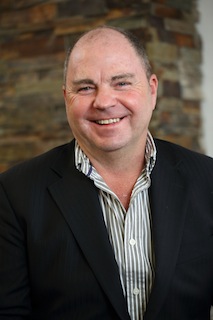Featured News
Newsroom
East coast floods highlight the need for Australia to mandate rapid shutdown for safer solar systems
- Details
- In Safer Solar
- /
 Wilf Johnston, GM ANZ for Safer Solar member Enphase EnergyThe flooding of thousands of homes on the East Coast has highlighted the need for Australia to mandate rapid shutdown technology on solar photovoltaic (PV) systems, warns industry group Safer Solar.
Wilf Johnston, GM ANZ for Safer Solar member Enphase EnergyThe flooding of thousands of homes on the East Coast has highlighted the need for Australia to mandate rapid shutdown technology on solar photovoltaic (PV) systems, warns industry group Safer Solar.
With solar panels installed on one in four Australian homes, many systems lack a quick and easy way to shut down solar panels in the event of a fault or emergency, creating a serious safety threat for homeowners, first responders and tradespeople. Solar panels that were not shut off before the floods may begin generating electricity when the sun shines, potentially without the safety systems designed to protect people from uncontrolled high-voltage electrical currents.
More than 90 per cent of rooftop solar PV systems installed in Australia include high voltage Direct Current (DC) wiring that is live whenever the sun is shining. This 600-1000 volt current, which cannot be shut off during daylight, can jump a 100mm gap between a system component and any earthed conductive material. Any break in wiring insulation or weather sealing of components can allow an electrical arc to form. Approaching 1000 degrees Celsius, this arc is hot enough to ignite fires - and does so more than twice every day in Australia. It can also deliver a lethal electric shock.
MIMP delivers affordable gigabit-speed Internet services for businesses in Whyalla and Mount Gambier
- Details
- In MIMP
- /
 MIMP CEO Allan AitchisonBusinesses in Whyalla and Mount Gambier can now access ultra-fast download speeds at affordable prices from $49.90 per month using the GigCity Internet service, deployed by MIMP connecting solutions.
MIMP CEO Allan AitchisonBusinesses in Whyalla and Mount Gambier can now access ultra-fast download speeds at affordable prices from $49.90 per month using the GigCity Internet service, deployed by MIMP connecting solutions.
Launched earlier this month, the first regional deployments of the GigCity network, in Whyalla and Mount Gambier, are great news for businesses in both cities. About 40 businesses already use GigCity for gigabit-speed Internet access across the two regional centres. In metropolitan Adelaide, the GigCity network is now used by more than 500 businesses at 23 South Australian business and innovation precincts.
Funded by the South Australian Government, infrastructure for GigCity network in Whyalla and Mount Gambier was designed and delivered by SA company MIMP connecting solutions. This regional GigCity network is operated by WideNetworks http://widenet.com.au .
MIMP connecting solutions CEO Allan Aitchison said the gigabit-speed regional networks were based on the latest micro-wave technology, with a 10-gigabit wireless ring around each city and fibre-optic links back to Adelaide. “The GigCity networks make Internet access much faster and less expensive for businesses in both Mount Gambier and Whyalla,” he said.
- Details
- In CitrusAd
- /
 CitrusAd CEO and co-founder Brad MoranCheck out this interview with former AFL footballer and eCommerce entrepreneur Brad Moran, who last year sold his four-year-old business CitrusAd for $205 million. In the hour-long chat with Add to Cart podcast host Nathan Bush, Brad explains how CitrusAd became a $200M+ acquisition target by enabling retailers like Woolworths and Coles in Australia and Tescos and Target internationally to monetise the “digital shelves” on their eCommerce retailing sites.
CitrusAd CEO and co-founder Brad MoranCheck out this interview with former AFL footballer and eCommerce entrepreneur Brad Moran, who last year sold his four-year-old business CitrusAd for $205 million. In the hour-long chat with Add to Cart podcast host Nathan Bush, Brad explains how CitrusAd became a $200M+ acquisition target by enabling retailers like Woolworths and Coles in Australia and Tescos and Target internationally to monetise the “digital shelves” on their eCommerce retailing sites.
In an episode called Horses are Better than Unicorns, Brad explains how he grew CitrusAd by listening and responding to retailers and equipping them to earn from $5000 a month to $10 million a month in extra advertising revenue. He also reveals how growth stalled for CitrusAd during the first six months of the COVID-19 pandemic and warns that Australian retailers need to embrace digital retail media systems within 12 months in order to defend themselves against an onslaught by the “Amazon ecosystem” within the next three to five years.
You can listen to Brad Moran’s Add to Cart interview at https://shows.acast.com/add-to-cart/episodes/horses-are-better-than-unicorns-the-citrusad-story-164.
- Details
- In Redflow
- /
 Underwriters Laboratories, SES and Redflow at Stress Texas Facility 24th January 2022. Left to Right: Judy Jeevarajan, Ph.D., vice president and executive director of Electrochemical Safety Research Institute (ESRI), Underwriters Laboratories Inc.; Daniel Juarez-Robles, Ph.D., research scientist, ESRI, Underwriters Laboratories Inc.; Steven Kinyon, Ph.D., P.E., principal, SES; Steve Hickey, CTO, Redflow; Carlos Lopez, P.E., senior associate, SES; Tim Harris, CEO Redflow
Underwriters Laboratories, SES and Redflow at Stress Texas Facility 24th January 2022. Left to Right: Judy Jeevarajan, Ph.D., vice president and executive director of Electrochemical Safety Research Institute (ESRI), Underwriters Laboratories Inc.; Daniel Juarez-Robles, Ph.D., research scientist, ESRI, Underwriters Laboratories Inc.; Steven Kinyon, Ph.D., P.E., principal, SES; Steve Hickey, CTO, Redflow; Carlos Lopez, P.E., senior associate, SES; Tim Harris, CEO Redflow
Underwriters Laboratories Inc. has selected Redflow ZBM batteries to carry out research to characterize the operating and safety profile of redox flow batteries under nominal and off-nominal conditions.
The Electrochemical Safety Research Institute at Underwriters Laboratories has undertaken the test program in collaboration with Stress Engineering Services Inc. (SES) and Redflow to understand key technical attributes of redox flow batteries, study their cycle life and aging properties and to understand how the batteries behave under off-nominal conditions of overcharge, over-discharge and external short-circuit conditions. Six Redflow batteries were purchased by Underwriters Laboratories in 2021 and arrived at the SES facility in Texas in December. The test program commenced in January 2022 and will run for a number of months.
“We are delighted to be working with industry leaders Underwriters Laboratories and SES to verify the performance and safety characteristics of flow battery storage using our Redflow batteries,” said Tim Harris, managing director and CEO of Redflow. “Redflow’s CTO Steve Hickey and I were able to meet the Underwriters Laboratories and SES teams at their Texas facility last month to advise on the setup of the Redflow batteries and provide broader input on the test program.”
More News...
- Adelaide skills-building centre unveils volunteer auction to fund move into post-pandemic life (21 February 2022)
- Enphase donates microinverters for $1.3M rebuild of Kangaroo Island hall destroyed by Black Summer bushfire (09 February 2022)
- Australian retailers risk missing rising wave of retail media spending in 2022 warns CitrusAd (07 February 2022)
- AI-powered workforce optimisation leader LIFELENZ raises US$32M to fund global growth (03 February 2022)
- Redflow completes 2 MWh installation in California (20 December 2021)
- Solar Juice signs up to distribute Enphase products as 2022 beckons to become the ‘year of the battery’ (13 December 2021)
- NSW services club expects three-year payback after installing 215kWp Enphase-equipped solar system (06 December 2021)
- Wollongong City Council cuts energy costs by 25% using Enphase microinverters for solar carpark (29 November 2021)
- Gumeracha Hotel’s smart Messenger takeaway ordering service aligns with success (17 November 2021)
- Australian eCommerce platform disrupter Ultra Commerce makes latest strategic acquisition for global growth (04 November 2021)
Off the Cuff

Simon Hackett speaks about Formula E racing on ABC Radio Adelaide
Australian renewable energy investor Simon Hackett last week spoke to Radio ABC Adelaide's Afternoons host Sonya Feldhoff about the benefits for replacing the cancelled Adelaide 500 motor race with a...
Read more
Seven simple steps for mental health in time of coronavirus
After the summer bushfires, the coronavirus pandemic and associated economic shutdown, “unprecedented” must be a standout favourite for Macquarie Dictionary’s Word of the Year for 2020. For the first time...
Read more
John Harris talks (a bit) about International Albinism Awareness Day on ABC Radio
John Harris, who has the honorary role of PR guy for the Albinism Fellowship of Australia, was interviewed by Peter Goers on the Evenings show of ABC Radio Adelaide on...
Read more
Start-ups are key to the future of everything
Nigel Lake, Executive Chair of global business advisory firm Pottinger, will tell this week's Myriad start-ups festival in Brisbane, running May 16-19, that Australia needs start-ups to protect its prosperity. Pottinger...
Read moreContact
Impress Media Australia
P: +61 8 8431 4000
E: john@impress.com.au
W: www.impress.com.au
Street:
Impress Media Australia
313 Portrush Road,
Norwood SA 5067
Click here for our location
Postal:
Impress Media Australia
Box 95, Kensington Park
South Australia 5068







